Abstract
Bulk III-nitride materials MN (M = Al, Ga and In) and their alloys have been widely used in high-power electronic and optoelectronic devices, but stable two-dimensional (2D) III-nitride materials, except h-BN, have not been realized yet. A new kind of 2D III-nitride material MSiN (M = Al, Ga and In) is predicted by choosing Si as the appropriate passivation element. The stability, electronic and optical properties of 2D MSiN materials are studied systematically based on first-principles calculations. The results show that AlSiN and GaSiN are found to be indirect bandgap semiconductors, while InSiN is a direct bandgap semiconductor. Moreover, AlSiN and InSiN have good absorption ability in the visible light region, while GaSiN is an ultraviolet-light-absorbing material. Furthermore, the carrier lifetimes of GaSiN and InSiN are as large as 157.89 and 103.99 ns, respectively. All these desirable properties of MSiN materials make them attractive for applications in electronics and photoelectronics.
1. Introduction
As third-generation semiconductors, bulk III-nitride materials, except h-BN, such as InN, GaN, AlN and their alloys, have attracted considerable attention for the application of high-power electronic and optoelectronic devices because of their tunable direct bandgap, high electron saturation mobility, high breakdown voltage and other unique properties [1,2,3,4,5]. Most of these applications are developed based on three-dimensional III-nitride materials, while a small part of them are developed based on zero-dimensional quantum dots or one-dimensional nanowires. Inspired by the fabrication of graphene and its remarkable properties driven by strong electron confinement in a two-dimensional (2D) limit, it is of great significance to study 2D III-nitride materials, which are pivotal to the development of low-power consumption devices and flexible electronic devices.
To date, various research works have been conducted to explore the structural and electronic properties of 2D III-nitride materials. On the one hand, theoretical simulations and calculations show that 2D AlN/GaN/InN monolayers exhibit a graphene-like structure, with each metal atom connected with three N atoms. Their bandgaps are much larger than those of bulk counterparts, and their exciton binding energies are as large as 0.6–1.9 eV [6] due to the sp or sp+sp hybridizations. Apart from the graphene-like hexagonal structure, other possible structures for 2D III-nitride monolayer have also been predicted, such as haeckelite GaN (T-GaN) [7], polyporous H-GaN [8] and planar allotropes of AlN [9]. More potential applications have been proposed for the 2D III-nitride monolayers [10,11]. On the other hand, there have been many attempts to experimentally synthesize 2D AlN, GaN or InN monolayers. Unfortunately, the synthesis of stable III-nitride monolayers with graphene-like hexagonal structures has not been realized until now. Although ultrathin 2D AlN, GaN or InN nanosheets have been verified in some limited reports [12,13], the poor stability and strict experimental conditions need to be improved. By contrast, there are some studies reporting the epitaxial growth of 2D III-nitride multilayers sandwiched by graphene and substrate. Robinson and co-workers reported the synthesis of 2D GaN via a migration-enhanced encapsulated growth (MEEG) technique utilizing epitaxial graphene [14], in which the buckled GaN layers were sandwiched by graphene multilayers and SiC substrate. Thereafter, a similar method was used to synthesize 2D AlN or InN layers sandwiched by graphene and SiC substrate [15,16]. Obviously, graphene plays a pivotal role in stabilizing these 2D buckled structures. Decomposition and oxidation might be expected when removing the graphene covering layer. The reasons for the difficulty in preparating 2D III-nitride materials can be attributed to unsaturated dangling bonds on the surfaces of group III-nitrides, large lattice mismatch in heteroepitaxy and the low rate of lateral migration [11].
Recently, Ren and co-workers introduced elemental silicon during chemical vapor deposition growth of nonlayered molybdenum nitride, which enabled the growth of a new 2D material, MoSiN [17]. This is a new general strategy to achieve 2D materials using appropriate elements to passivate the high-energy surfaces of nonlayered materials during growth. Afterwards, a new 2D family MAZ (M = transition mental; A = C, Si and Ge; and Z = N, P and As) was explored, which shows potential applications in photocatalytic catalysts, spintronics and optoelectronics [18,19]. According to this method, new 2D III-nitrides would be designed by choosing an appropriate passivation element, which has not been studied yet.
Herein, 2D III-nitrides MSiN (M = Al, Ga and In) with octuple atomic layers are predicted based on the first-principles calculations. The mechanical, thermal and dynamic stabilities of MSiN monolayers are confirmed carefully. Among them, AlSiN is an indirect bandgap semiconductor with a bandgap of 1.21 eV, while InSiN is a direct bandgap semiconductor with a bandgap of 1.49 eV. The transition from indirect bandgap in AlSiN to direct bandgap in InSiN can be attributed to pd coupling due to the existence of occupied In:d bands. Moreover, 2D MSiN monolayers show high lightharvesting ability in visible and ultraviolet wavelength regions. Most importantly, the carrier lifetimes of GaSiN and InSiN are calculated to be as large as 157.89 and 103.99 ns, respectively. Our results demonstrate potential applications of MSiN monolayers in the next-generation optoelectronic technologies.
2. Computational Methods
The ground-state electronic properties were calculated using the density functional theory (DFT)-based [20] first-principles method implemented in the Vienna ab initio simulation package (VASP) [21,22]. The generalized gradient approximation (GGA) of Perdew-Burke-Ernzerhof (PBE) functionals [23,24] was adopted to model the exchange–correlation interactions. The electronic interactions were described by projector-augmented-wave (PAW) potentials [22,25]. The cutoff energy for the plane-wave basis was set to be 550 eV, and the -centered 15 × 15 × 1 k-point mesh was adopted to sample the Brillouin zone (BZ) [26,27]. To make the interactions between adjacent layers negligible, the vacuum layer thickness along the z direction was built to be ≈ 15 Å. Moreover, the convergence criteria for total energy and atomic forces were 10 eV and 0.001 eV/Å, respectively. The phonon spectra were obtained in the framework of density functional perturbation theory (DFPT) by PHONOPY code [28]. The ab initio molecular dynamics (AIMD) simulations using Nosé-Hoover thermostat under the NVT ensemble were used to evaluate the thermal stability within a 4 × 4 × 1 supercell. Some data postprocessing for VASP calculations was performed by VASPKIT code [29]. The carrier lifetimes were calculated using nonadiabatic molecular dynamics (NAMD) simulations with the Hefei-NAMD code [30].
To consider the exciton effects, the PBE energies were corrected by the GW approximation according to Green’s function equations, as implemented in Yambo software [31,32]. The ground-state Kohn-Sham energies and wave functions were obtained with the QUANTUM ESPRESSO (QE) package [33,34]. The norm-conserving Vanderbilt pseudopotentials [35] with a kinetic energy cutoff of 100 Ry and the charge density cutoff of 400 Ry were selected to describe the electron-ion interactions. In order to converge the quasi-particle energy gap, the total number of bands was set to be 12 times the number of valence bands, and the cutoff energy was set to be 20 Ry for the response function in the GW step. The absorption spectra were obtained by the solution of the Bethe-Salpeter equation (BSE) [36], for which the seven highest valence bands and seven lowest conduction bands were set to describe the excitons.
3. Results and Discussion
The MSiN (M = Al, Ga and In) monolayers possess a space group of Pm2 with a D point group symmetry, as shown in Figure 1. There are octuple atomic layers with the sequence of N-Si-N-M-M-N-Si-N in MSiN monolayer, which can be constructed by intercalating an InSe-type monolayer MN into the middle of two Si-N bilayers. There are two kinds of N atoms, named N1 and N2, based on the difference of coordination number. Furthermore, the stability of MSiN monolayers are conformed by the calculations of phonon spectra, elastic stiffness constants and AIMD sumulations. Firstly, two independent elastic constants for 2D hexagonal crystals, C and C, are calculated based on the strain energy method [37], as shown in Table 1. The calculated C and C obviously meet the elastic stability criteria, i.e., C > 0 and C > |C|. The C of MSiN monolayer is as large as 459–572 N/m, even larger than that of graphene (340 N/m) [38]. Secondly, the phonon spectra of MSiN verify their dynamic stability because of the absence of imaginary frequency modes, as shown in Figure 2. Lastly, no signs of structural fracture and small energy fluctuations during AIMD simulations at the temperature range from 300 to 1000 K demonstrate the thermal stability of MSiN monolayers (Figure 2 and Figure S1 in Supplementary Materials). In brief, we predict new kinds of 2D material MSiN and confirm their stabilities. Next, their electronic and optical properties are studied in detail.
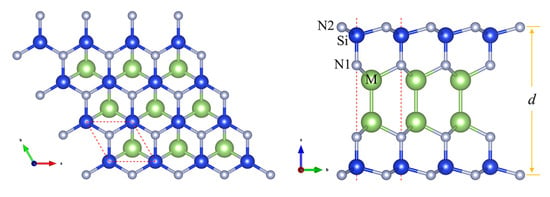
Figure 1.
Top (left panel) and side (right panel) views of MSiN (M = Al, Ga and In).

Table 1.
The calculated lattice constant a, thickness d, elastic constants C/C, energy gap E, optical gap E and exciton binding energy E from GW-BSE methods for MSiN monolayers.

Figure 2.
The phonon spectra and energy variations under the AIMD simulations at 300 K of (a) AlSiN, (b) GaSiN and (c) InSiN.
The relaxed lattice constant of MSiN (M = Al, Ga and In) is in the range of 2.97–3.14 Å (Table 1). To achieve deep insights into the bonding nature of MSiN, we then calculate the deformation electron density and electron localization function (ELF) (Figure 3). We can find obvious charge accumulation around N atoms and in the middle of metal atoms, while charge depletion mainly occurs around Si and metal atoms due to the large electronegativity difference between N and Si/M atoms. The ELF plots show that N–Si bonds have mainly covalent bonding interactions. It is worth noting that N–M bonds switch from mainly covalent bonding in AlSiN to a mixture of covalent and ionic bonds in GaSiN and InSiN. The Al–Al, Ga–Ga and In–In bond distances are 2.62, 2.47 and 2.78 Å, respectively, which are shorter than those in bulk Al (2.86 Å), Ga (2.53 Å) and In (3.31 Å). Moreover, Bader [39] charges calculations (Table S1) show that the numbers of electrons transferred from the metal atoms to surrounding atoms are 1.65, 1.06 and 0.97 |e| in AlSiN, GaSiN and InSiN, respectively. At the same time, electrons transferred to N1 atoms decrease from 2.37 |e| in AlSiN to 1.79 (1.71) |e| in GaSiN (InSiN). For N2 and Si atoms, transferred electrons are almost the same in the three systems.
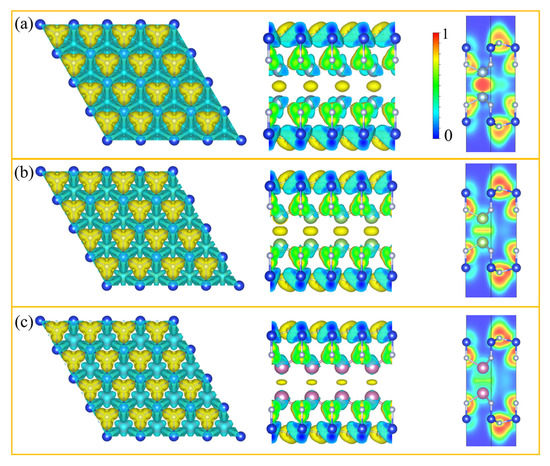
Figure 3.
The top and side views of the deformation electron density and electron localization function (ELF) map sliced perpendicularly to (110) direction for (a) AlSiN, (b) GaSiN and (c) InSiN. The isovalue is set to be 0.01 e/Bohr. The deformation electron density is defined as the MSiN monolayer total charge density, subtracting the sum of isolated atoms. The charge accumulation and depletion regions are shown in yellow and blue, respectively.
The projected electronic band structures and density of states are calculated based on DFT-PBE level, as shown in Figure 4. For AlSiN, it is an indirect bandgap semiconductor (1.21 eV) with valence band maximum (VBM) located at the K point and conduction band minimum (CBM) located at the M point. The conduction (CBE) and valence (VBE) band edges are mainly determined by N1:p states and Al:p states, respectively (Figure S2). For GaSiN, VBM is located at a special point near K, and CBM is located at the M point, resulting an indirect bandgap of 2.84 eV, while the CBE and VBE are mainly determined by Ga:p and Ga:p,d states hybridized with N1:p, respectively. Most importantly, InSiN is a direct-bandgap (1.49 eV) semiconductor, with both CBM and VBM located at the point, while CBE mainly originates from the hybridized In:s,p and N1:s,p states, and VBE is mainly determined by N1:p states. The band edge switch is clearly related with the occupied d orbitals in GaSiN and InSiN, which are absent in the AlSiN monolayer (Figure S3). In order to explore the origin of the indirect-to-direct bandgap transfer, we plot the atomic orbital components of the highest valence band and the lowest conduction band at , M and K points for three MSiN monolayers, as shown in Figure 5. From Figure 5a, we can see that the highest valence band at is composed of N1:p states in AlSiN and hybridized N1:p and M:d states in GaSiN (InSiN). The pd couplings only emerging in GaSiN/InSiN would push valence energy level at point up [40]. Although the pd couplings would also push the energy level at K and M points up, the energy increase at might be larger than that at the K and M points because of the higher percentage of p and d orbitals in compared with K and M points (Figure 5c,e), finally resulting in the valence energy level at to be the highest among the three points, i.e., leading to be VBM in InSiN. On the contrary, the pd coupling would push the conduction energy levels at M and K points up, leading the conduction energy level at to be the lowest among the three points, i.e., becoming CBM in InSiN. In one word, the existence of occupied d orbitals plays a key role in determining the directness or indirectness of bandgap in MSiN.
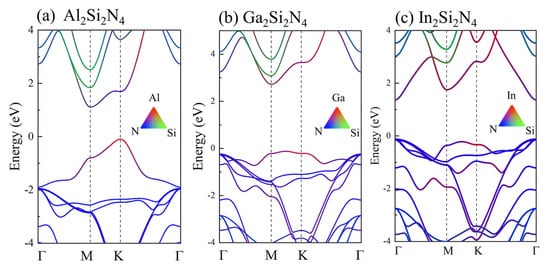
Figure 4.
The projected electronic band structure and density of states (DOS) of (a) AlSiN, (b) GaSiN and (c) InSiN. The Fermi energy is set to 0 eV.
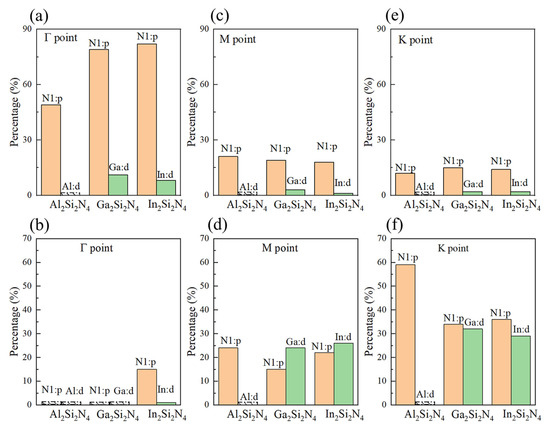
Figure 5.
Atomic orbital components of the highest valence band and the lowest conduction band at , (a,b) M (c,d) and K points (e,f). The blank boxes indicate zero.
Generally, the exciton binding energy is very large in ultrathin 2D materials, such as 0.63 eV in MoS [41], 0.7 eV in InSe [42] and 0.6–2.0 eV in graphene-like h-MN (M = B, Al, Ga and N) [6]. Considering the relatively large thickness of MSiN, it is necessary to study the relationship between exciton binding energy and the thickness of 2D materials. Based on GW-BSE methods, we calculate the quasi-particle bandgaps, exciton binding energy (Table 1) and imaginary parts of the dielectric function (Figure 6) of MSiN monolayers. The first prominent peak defined as the optical gap E is located at 2.18, 3.95 and 1.73 eV for AlSiN, GaSiN and InSiN, respectively. This excitonic peak corresponds to the interband transition from the highest valence band to the lowest conduction band at the K, M and points for AlSiN, GaSiN and InSiN, respectively. Furthermore, the exciton binding energies are calculated to be 0.44, 0.54 and 0.38 eV. It is clear that the larger thickness of materials (Table 1) results in smaller exciton binding energy. From Figure 6, the absorbance spectra of AlSiN and InSiN have a large overlap with the AM1.5G solar flux in the visible wavelength region, demonstrating their potential application in detectors or solar cells. Moreover, the 2D GaSiN monolayer shows high lightharvesting ability in the ultraviolet wavelength region.
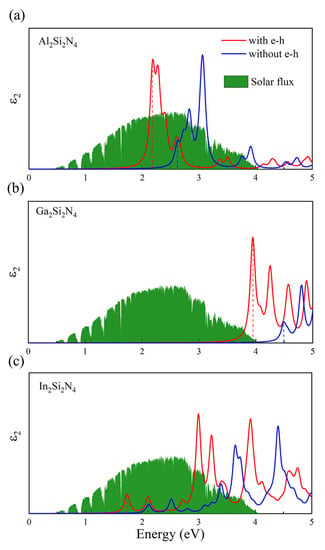
Figure 6.
Imaginary part of the dielectric function of (a) AlSiN, (b) GaSiN and (c) InSiN. The spectra with e-h interaction and without e-h interaction were calculated on the basis of GW-BSE and GW-RPA methods, respectively. The standard AM1.5 G solar flux is shown to reflect the light capture ability.
Apart from good lightharvesting ability, the lifetime of excited carriers also plays an important role in the power conversion efficiency in solar cell devices. Thus, we calculate the photogenerated carrier lifetimes driven by nonadiabatic (NA) processes in MSiN monolayers. According to Fermi’s golden rule and Marcus theory [43,44], a larger band gap, a weaker nonadiabatic coupling (NAC) and a shorter pure-dephasing time would result in a smaller e-h recombination rate and longer carrier lifetime. During the nonequilibrium NA processes, the extra energy of electrons is transferred to the involved nuclei triggered by inelastic electron-phonon couplings, dissipating as heat. The eh recombination rate is proportional to the square of the NAC constant [45], which is determined by the overlap between the initial and final electronic states and the phonon velocity [46]. The calculated NAC is 0.97, 0.55 and 0.30 meV for AlSiN, GaSiN and InSiN, respectively. Large NAC would result in high e-h recombination rate and short carrier lifetime. To analyze the phonon modes that drive e-h recombination, the vibrational spectral densities calculated by a Fourier transform (FT) of gap autocorrelation functions (ACFs) are plotted in Figure 7b. For the AlSiN monolayer, the low vibration frequencies in the range of 10–40 cm participate in the nonradiative e-h recombination, and the largest spectral densities reflect stronger electron-phonon (e-ph) interactions, leading to the largest NAC among the three materials. For GaSiN and InSiN, the dominating peak frequencies are located at 125 and 350 cm, respectively.
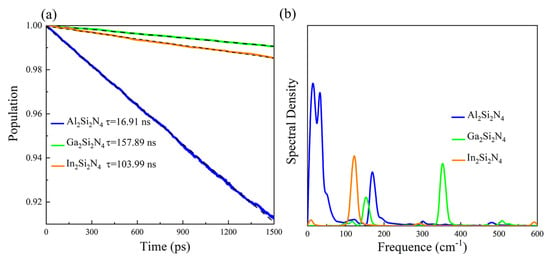
Figure 7.
Excited–state carriers’ population decay (a) and spectral densities (b) of MSiN.
In addition to inelastic electron-phonon couplings, elastic electron-phonon coupling also has an impact on the recombination of photogenerated carriers, which results in a loss of the phase relationship in a quantum-mechanical superposition between VBM and CBM [46]. The pure-dephasing functions are shown in Figure S4, and the dephasing times T of AlSiN, GaSiN and InSiN are 25.4, 13.0 and 9.6 fs, respectively. For AlSiN, the initial un-normalized ACF (uACF) value is the smallest among the three materials (Figure S4), corresponding to the longest pure-dephasing time. However, a shorter pure-dephasing time would lead to a smaller e-h recombination rate and thus longer carrier lifetime. Taking into consideration the above inelastic and elastic factors, we obtain the decay of the carrier populations through the bandgap for three MSiN monolayers, as shown in Figure 7a. Additionally, the carrier lifetime is evaluated by a short-time linear fitting to the exponential decay, f(t) = exp(−t/) ≈ 1 − t/. At last, the e-h recombination lifetimes are calculated to be 16.91, 157.89 and 103.99 ns for AlSiN, GaSiN and InSiN, respectively. Two-dimensional GaSiN has the longest carrier lifetime of 157.89 ns, due to the largest bandgap, relatively small NAC and dephasing time (Table S2). Most importantly, the simulated carrier lifetime in GaSiN and InSiN reaches a one hundred nanosecond level, which is much larger than that in previous reported materials, such as MoS (0.39 ns) [47], 1T-TiOF (2.8 ns) [48], MAPbI perovskite (12.0 ns) [49], bulk GaN (40 ns) [50] and bulk InN [51]. The long carrier lifetime of 2D MSiN highlights their potential in optoelectronic and photovoltaic applications.
4. Conclusions
In this work, a new kind of 2D material MSiN (M = Al, Ga and In) with octuple atomic layers is predicted and studied based on first-principles calculations. Firstly, three 2D MSiN monolayers show high mechanical, thermal and dynamic stabilities. Secondly, AlSiN and GaSiN have an indirect bandgap of 1.21 and 2.84 eV, respectively, while InSiN is a direct semiconductor with a bandgap of 1.49 eV. The indirect-to-direct bandgap transition in MSiN is analyzed and attributed to pd couplings due to the existence of occupied Ga:d or In:d orbitals. Thirdly, AlSiN and InSiN have strong optical absorption in the visible light region, while GaSiN shows high lightharvesting ability in the ultraviolet light region. The exciton binding energy is calculated to be 0.44, 0.54 and 0.38 eV for AlSiN, GaSiN and InSiN, respectively, which is a relatively small value in the 2D materials family. Most importantly, the carrier lifetimes of GaSiN and InSiN are as large as 157.89 and 103.99 ns, respectively. Overall, these attractive properties make 2D MSiN materials promising candidates for optoelectronic and photovoltaic applications.
Supplementary Materials
The following supporting information can be downloaded at: https://www.mdpi.com/article/10.3390/mi14020405/s1, Figure S1: Energy variations under the AIMD simulations at 1000 and 1200 K of (a) Al2Si2N4, (b) Ga2Si2N4 and (c) In2Si2N4. Figure S2: The projected density of states (PDOS) of (a) Al2Si2N4, (b) Ga2Si2N4 and. (c) In2Si2N4. Figure S3: The density of states for Ga:d and In:d in Ga2Si2N4 and In2Si2N4. Figure S4: Pure-dephasing functions and unnormalized autocorrelation functions of the electronic energy gap fluctuations for (a) Al2Si2N4, (b) Ga2Si2N4 and (c) In2Si2N4. Table S1: The calculated Bader charge and work function for M2Si2N4. Positive values mean electron loss, and negative values mean electron gains. Table S2: The calculated bandgap Eg, average NAC, pure-dephasing time T and nonradiative electron-hole recombination time in M2Si2N4.
Author Contributions
Conceptualization, Y.D.; formal analysis, Y.Y. and L.Y.; writing—original draft preparation, Y.D.; writing—review and editing, K.X., J.Z. and Q.L.; supervision, L.Z.; funding acquisition, L.Z. All authors have read and agreed to the published version of the manuscript.
Funding
This work was supported by the Startup funds of Outstanding Talents of UESTC (No. A1098531023601205), the National Youth Talents Plan of China (G05QNQR049), and the Open-Foundation of Key Laboratory of Laser Device Technology, China North Industries Group Corporation Limited (KLLDT202106).
Data Availability Statement
The data presented in this study are available on request from the corresponding author.
Conflicts of Interest
The authors declare no conflict of interest.
References
- Brunner, D.; Angerer, H.; Bustarret, E.; Freudenberg, F.; Höpler, R.; Dimitrov, R.; Ambacher, O.; Stutzmann, M. Optical constants of epitaxial AlGaN films and their temperature dependence. J. Appl. Phys. 1997, 82, 5090–5096. [Google Scholar] [CrossRef]
- Narukawa, Y.; Ichikawa, M.; Sanga, D.; Sano, M.; Mukai, T. White light emitting diodes with super-high luminous efficacy. J. Phys. D Appl. Phys. 2010, 43, 354002. [Google Scholar] [CrossRef]
- Hurni, C.A.; David, A.; Cich, M.J.; Aldaz, R.I.; Ellis, B.; Huang, K.; Tyagi, A.; DeLille, R.A.; Craven, M.D.; Steranka, F.M.; et al. Bulk GaN flip-chip violet light-emitting diodes with optimized efficiency for high-power operation. Appl. Phys. Lett. 2015, 106, 031101. [Google Scholar] [CrossRef]
- Geng, C.; Wei, T.; Wang, X.; Shen, D.; Hao, Z.; Yan, Q. Enhancement of light output power from LEDs based on monolayer colloidal crystal. Small 2014, 10, 1668–1686. [Google Scholar] [CrossRef] [PubMed]
- Spies, M.; Den Hertog, M.I.; Hille, P.; Schörmann, J.; Polaczynski, J.; Gayral, B.; Eickhoff, M.; Monroy, E.; Lähnemann, J. Bias-controlled spectral response in GaN/AlN single-nanowire ultraviolet photodetectors. Nano Lett. 2017, 17, 4231–4239. [Google Scholar] [CrossRef]
- Prete, M.S.; Grassano, D.; Pulci, O.; Kupchak, I.; Olevano, V.; Bechstedt, F. Giant excitonic absorption and emission in two-dimensional group-III nitrides. Sci. Rep. 2020, 10, 1–9. [Google Scholar] [CrossRef]
- Camacho-Mojica, D.C.; López-Urías, F. GaN haeckelite single-layered nanostructures: Monolayer and nanotubes. Sci. Rep. 2015, 5, 1–11. [Google Scholar] [CrossRef]
- Zhang, H.; Meng, F.S.; Wu, Y.B. Two single-layer porous gallium nitride nanosheets: A first-principles study. Solid State Commun. 2017, 250, 18–22. [Google Scholar] [CrossRef]
- Behnam Kazempour, E.K.S.; Rostami, R. Theoretical prediction of novel two-dimensional planar aluminum nitride allotropes: First principles calculations. Indian J. Phys. 2018, 92, 343–348. [Google Scholar] [CrossRef]
- Ben, J.; Liu, X.; Wang, C.; Zhang, Y.; Shi, Z.; Jia, Y.; Zhang, S.; Zhang, H.; Yu, W.; Li, D.; et al. 2D III-Nitride Materials: Properties, Growth, and Applications. Adv. Mater. 2021, 33, 2006761. [Google Scholar] [CrossRef]
- Wang, W.; Jiang, H.; Li, L.; Li, G. Two-dimensional group-III nitrides and devices: A critical review. Rep. Prog. Phys. 2021, 84, 086501. [Google Scholar] [CrossRef]
- Mansurov, V.; Malin, T.; Galitsyn, Y.; Zhuravlev, K. Graphene-like AlN layer formation on (111) Si surface by ammonia molecular beam epitaxy. J. Cryst. Growth 2015, 428, 93–97. [Google Scholar] [CrossRef]
- Syed, N.; Zavabeti, A.; Messalea, K.A.; Della Gaspera, E.; Elbourne, A.; Jannat, A.; Mohiuddin, M.; Zhang, B.Y.; Zheng, G.; Wang, L.; et al. Wafer-sized ultrathin gallium and indium nitride nanosheets through the ammonolysis of liquid metal derived oxides. J. Am. Chem. Soc. 2019, 141, 104–108. [Google Scholar] [CrossRef]
- Al Balushi, Z.Y.; Wang, K.; Ghosh, R.K.; Vilá, R.A.; Eichfeld, S.M.; Caldwell, J.D.; Qin, X.; Lin, Y.C.; DeSario, P.A.; Stone, G.; et al. Two-dimensional gallium nitride realized via graphene encapsulation. Nat. Mater. 2016, 15, 1166–1171. [Google Scholar] [CrossRef]
- Kakanakova-Georgieva, A.; Gueorguiev, G.K.; Sangiovanni, D.G.; Suwannaharn, N.; Ivanov, I.G.; Cora, I.; Pécz, B.; Nicotra, G.; Giannazzo, F. Nanoscale phenomena ruling deposition and intercalation of AlN at the graphene/SiC interface. Nanoscale 2020, 12, 19470–19476. [Google Scholar] [CrossRef]
- Pécz, B.; Nicotra, G.; Giannazzo, F.; Yakimova, R.; Koos, A.; Kakanakova-Georgieva, A. Indium nitride at the 2D limit. Adv. Mater. 2021, 33, 2006660. [Google Scholar] [CrossRef]
- Hong, Y.L.; Liu, Z.; Wang, L.; Zhou, T.; Ma, W.; Xu, C.; Feng, S.; Chen, L.; Chen, M.L.; Sun, D.M.; et al. Chemical vapor deposition of layered two-dimensional MoSi2N4 materials. Science 2020, 369, 670–674. [Google Scholar] [CrossRef]
- Wang, L.; Shi, Y.; Liu, M.; Zhang, A.; Hong, Y.L.; Li, R.; Gao, Q.; Chen, M.; Ren, W.; Cheng, H.M.; et al. Intercalated architecture of MA2Z4 family layered van der Waals materials with emerging topological, magnetic and superconducting properties. Nat. Commun. 2021, 12, 1–10. [Google Scholar] [CrossRef]
- Lin, C.; Feng, X.; Legut, D.; Liu, X.; Seh, Z.W.; Zhang, R.; Zhang, Q. Discovery of Efficient Visible-light Driven Oxygen Evolution Photocatalysts: Automated High-Throughput Computational Screening of MA2Z4. Adv. Funct. Mater. 2022, 32, 2207415. [Google Scholar] [CrossRef]
- Kohn, W.; Becke, A.D.; Parr, R.G. Density functional theory of electronic structure. J. Phys. Chem. 1996, 100, 12974–12980. [Google Scholar] [CrossRef]
- Kresse, G.; Furthmüller, J. Efficient iterative schemes for ab initio total-energy calculations using a plane-wave basis set. Phys. Rev. B 1996, 54, 11169. [Google Scholar] [CrossRef] [PubMed]
- Kresse, G.; Joubert, D. From ultrasoft pseudopotentials to the projector augmented-wave method. Phys. Rev. B 1999, 59, 1758. [Google Scholar] [CrossRef]
- Perdew, J.P.; Chevary, J.A.; Vosko, S.H.; Jackson, K.A.; Pederson, M.R.; Singh, D.J.; Fiolhais, C. Atoms, molecules, solids, and surfaces: Applications of the generalized gradient approximation for exchange and correlation. Phys. Rev. B 1992, 46, 6671. [Google Scholar] [CrossRef] [PubMed]
- Perdew, J.P.; Burke, K.; Ernzerhof, M. Generalized gradient approximation made simple. Phys. Rev. Lett. 1996, 77, 3865. [Google Scholar] [CrossRef]
- Blöchl, P.E. Projector augmented-wave method. Phys. Rev. B 1994, 50, 17953. [Google Scholar] [CrossRef]
- Monkhorst, H.J.; Pack, J.D. Special points for Brillouin-zone integrations. Phys. Rev. B 1976, 13, 5188. [Google Scholar] [CrossRef]
- Blöchl, P.E.; Jepsen, O.; Andersen, O.K. Improved tetrahedron method for Brillouin-zone integrations. Phys. Rev. B 1994, 49, 16223. [Google Scholar] [CrossRef]
- Togo, A.; Tanaka, I. First principles phonon calculations in materials science. Scr. Mater. 2015, 108, 1–5. [Google Scholar] [CrossRef]
- Wang, V.; Xu, N.; Liu, J.C.; Tang, G.; Geng, W.T. VASPKIT: A user-friendly interface facilitating high-throughput computing and analysis using VASP code. Comput. Phys. Commun. 2021, 267, 108033. [Google Scholar] [CrossRef]
- Zheng, Q.; Chu, W.; Zhao, C.; Zhang, L.; Guo, H.; Wang, Y.; Jiang, X.; Zhao, J. Ab initio nonadiabatic molecular dynamics investigations on the excited carriers in condensed matter systems. Wiley Interdiscip. Rev. Comput. Mol. Sci. 2019, 9, e1411. [Google Scholar] [CrossRef]
- Marini, A.; Hogan, C.; Grüning, M.; Varsano, D. Yambo: An ab initio tool for excited state calculations. Comput. Phys. Commun. 2009, 180, 1392–1403. [Google Scholar] [CrossRef]
- Sangalli, D.; Ferretti, A.; Miranda, H.; Attaccalite, C.; Marri, I.; Cannuccia, E.; Melo, P.; Marsili, M.; Paleari, F.; Marrazzo, A.; et al. Many-body perturbation theory calculations using the yambo code. J. Phys. Condens. Matter 2019, 31, 325902. [Google Scholar] [CrossRef]
- Giannozzi, P.; Baroni, S.; Bonini, N.; Calandra, M.; Car, R.; Cavazzoni, C.; Ceresoli, D.; Chiarotti, G.L.; Cococcioni, M.; Dabo, I.; et al. QUANTUM ESPRESSO: A modular and open-source software project for quantum simulations of materials. J. Phys. Condens. Mat. 2009, 21, 395502. [Google Scholar] [CrossRef]
- Giannozzi, P.; Andreussi, O.; Brumme, T.; Bunau, O.; Nardelli, M.B.; Calandra, M.; Car, R.; Cavazzoni, C.; Ceresoli, D.; Cococcioni, M.; et al. Advanced capabilities for materials modelling with Quantum ESPRESSO. J. Phys. Condens. Mat. 2017, 29, 465901. [Google Scholar] [CrossRef]
- Hamann, D. Optimized norm-conserving Vanderbilt pseudopotentials. Phys. Rev. B 2013, 88, 085117. [Google Scholar] [CrossRef]
- Strinati, G. Application of the Green’s functions method to the study of the optical properties of semiconductors. La Riv. Del Nuovo Cimento (1978–1999) 1988, 11, 1–86. [Google Scholar] [CrossRef]
- Maździarz, M. Comment on “The Computational 2D Materials Database: High-throughput modeling and discovery of atomically thin crystals”. 2D Mater. 2019, 6, 048001. [Google Scholar] [CrossRef]
- Lee, C.; Wei, X.; Kysar, J.W.; Hone, J. Measurement of the elastic properties and intrinsic strength of monolayer graphene. Science 2008, 321, 385–388. [Google Scholar] [CrossRef]
- Henkelman, G.; Arnaldsson, A.; Jónsson, H. A fast and robust algorithm for Bader decomposition of charge density. Comput. Mater. Sci. 2006, 36, 354–360. [Google Scholar] [CrossRef]
- Yuan, L.D.; Deng, H.X.; Li, S.S.; Wei, S.H.; Luo, J.W. Unified theory of direct or indirect band-gap nature of conventional semiconductors. Phys. Rev. B 2018, 98, 245203. [Google Scholar] [CrossRef]
- Qiu, D.Y.; Felipe, H.; Louie, S.G. Screening and many-body effects in two-dimensional crystals: Monolayer MoS2. Phys. Rev. B 2016, 93, 235435. [Google Scholar] [CrossRef]
- Attaccalite, C.; Palummo, M.; Cannuccia, E.; Grüning, M. Second-harmonic generation in single-layer monochalcogenides: A response from first-principles real-time simulations. Phys. Rev. Mater. 2019, 3, 074003. [Google Scholar] [CrossRef]
- Marcus, R.A.; Sutin, N. Electron transfers in chemistry and biology. Biochim. Biophys. Acta (BBA)-Rev. Bioenerg. 1985, 811, 265–322. [Google Scholar] [CrossRef]
- Hyeon-Deuk, K.; Madrid, A.B.; Prezhdo, O.V. Symmetric band structures and asymmetric ultrafast electron and hole relaxations in silicon and germanium quantum dots: Time-domain ab initio simulation. Dalton Trans. 2009, 10069–10077. [Google Scholar] [CrossRef]
- Jankowska, J.; Long, R.; Prezhdo, O.V. Quantum dynamics of photogenerated charge carriers in hybrid perovskites: Dopants, grain boundaries, electric order, and other realistic aspects. ACS Energy Lett. 2017, 2, 1588–1597. [Google Scholar] [CrossRef]
- Wang, L.; Long, R.; Prezhdo, O.V. Time-domain ab initio modeling of photoinduced dynamics at nanoscale interfaces. Annu. Rev. Phys. Chem. 2015, 66, 549–579. [Google Scholar] [CrossRef]
- Li, L.; Long, R.; Bertolini, T.; Prezhdo, O.V. Sulfur adatom and vacancy accelerate charge recombination in MoS2 but by different mechanisms: Time-domain ab initio analysis. Nano Lett. 2017, 17, 7962–7967. [Google Scholar] [CrossRef]
- Yan, L.; Zhu, J.; Wang, B.T.; He, J.; Song, H.Z.; Chu, W.; Tretiak, S.; Zhou, L. Two Dimensional MOene: From Superconductors to Direct Semiconductors and Weyl Fermions. Nano Lett. 2022, 22, 5592–5599. [Google Scholar] [CrossRef]
- Li, W.; Tang, J.; Casanova, D.; Prezhdo, O.V. Time-domain ab initio analysis rationalizes the unusual temperature dependence of charge carrier relaxation in lead halide perovskite. ACS Energy Lett. 2018, 3, 2713–2720. [Google Scholar] [CrossRef]
- Ščajev, P.; Jarašiiūnas, K.; Okur, S.; Özgür, Ü.; Morkoç, H. Carrier dynamics in bulk GaN. J. Appl. Phys. 2012, 111, 023702. [Google Scholar] [CrossRef]
- Chen, F.; Cartwright, A.; Lu, H.; Schaff, W.J. Hole transport and carrier lifetime in InN epilayers. Appl. Phys. Lett. 2005, 87, 212104. [Google Scholar] [CrossRef]
Disclaimer/Publisher’s Note: The statements, opinions and data contained in all publications are solely those of the individual author(s) and contributor(s) and not of MDPI and/or the editor(s). MDPI and/or the editor(s) disclaim responsibility for any injury to people or property resulting from any ideas, methods, instructions or products referred to in the content. |
© 2023 by the authors. Licensee MDPI, Basel, Switzerland. This article is an open access article distributed under the terms and conditions of the Creative Commons Attribution (CC BY) license (https://creativecommons.org/licenses/by/4.0/).